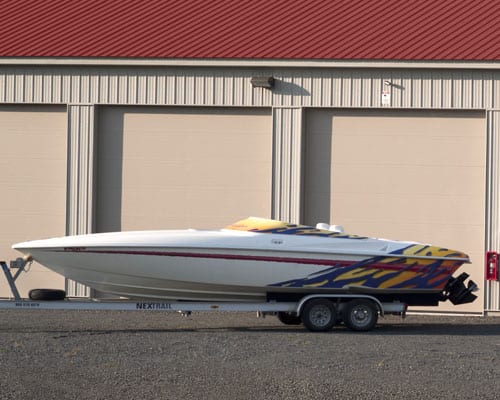 Winter’s biggest dangers to engines are freezing, corrosion, and fuel degradation. Because boats and engines differ, start by checking the winterizing/storage sections of your owner’s manual. Here are a few tips on storing your boat.
Winter’s biggest dangers to engines are freezing, corrosion, and fuel degradation. Because boats and engines differ, start by checking the winterizing/storage sections of your owner’s manual. Here are a few tips on storing your boat.
STEP 1: REPLACE ENGINE OIL
Moisture and acids in old oil will pit bearings and other engine parts while in storage, so you need to drain it. First, warm up the engine, using engine muffs to supply water to the engine, so more of the dirty oil will drain out and impurities will flush out more easily. Then use high-quality oil and filters as recommended by your engine’s manufacturer. Change the oil and filter before storing for the winter.
STEP 2: FLUSH AND DRAIN COOLING WATER
To prevent damage from expanding water when it freezes, you must drain water from your engine.
For inboard and sterndrive engines: Flush the engine with clean water by using water muffs or a similar device to connect a garden hose to your cooling system. (Never run a water engine without water.) Then flush until the engine reaches normal operating temperature.
Next, remove drain plugs. These are usually located in the engine block and manifold. You may also need to remove the water pump hose to drain remaining water.
For outboard engine maintenance: First, make sure all drain holes are open. Then start the engine and clean the cooling system by flushing it with fresh water. (Use water muffs or a similar device connected to a garden hose.) Flush for a few minutes.
STEP 3: STABILIZE FUEL
Fuel can deteriorate in as little as 60 days, causing gum and varnish to build up in your engine. This results in hard starting, poor performance, and reduced engine life. The easiest way to prevent these problems is by adding a high-quality marine fuel stabilizer to prevent fuel deterioration.
Then fill the tank with fresh fuel to prevent corrosion-causing water condensation. Simply run the engine for a few minutes to get treated gas throughout the system—either when your boat is in the water or while using a fitting designed to run the engine with a garden hose.
STEP 4: PROTECT INTERNAL ENGINE COMPONENTS
While in storage, engine oil drains away. This exposes internal engine components to harsh elements in winter and can lead to corrosion and metal-to-metal contact, called cylinder scuffing, come spring.
To prevent these issues, use a fogging oil spray. This type of product is specially formulated to penetrate deep into the engine and coat parts with a protective layer of anti-corrosive compound.
STEP 5: REPLACE GEAR OIL
Drain the lower unit of old gear oil and replace with a fresh supply. When changing the gear oil, be sure to check for moisture. If water comes out first, or if you see milky or lumpy oil, this is an indication your boat is experiencing moisture contamination and will need new seals before next season.
STEP 6: GREASE AND LUBRICATE
Find your engine’s grease fittings (most will be in the steering mechanism area), then use a quality marine lubricant to protect against rust, corrosion, and oxidation. Check your owner’s manual to be sure you don’t miss any important areas that need to be greased before winter storage.
Other important annual maintenance:
- Check the hull, looking for stress cracks (common around the bow eye) and gelcoat blisters. Stress cracks can indicate structural damage, and anything serious should be looked at by a professional.
- Apply vinyl cleaners and protectants, available in gels and sprays, as they can prevent your vinyl from drying out and cracking.
- Vent your boat cabin and cover for good airflow to minimize trapped moisture.
- Spray all exposed electrical connections with a moisture-displacing lubricant.
- Wax the hull and topsides with a good quality marine wax.
- Be sure the cover is securely tied down or taped so wind won’t get underneath the cover.
These tips are a basic guide that was intended to assist you in winterizing your boat. It is extremely important that you read your owner’s manuals for unit specific winterizing guidelines.
